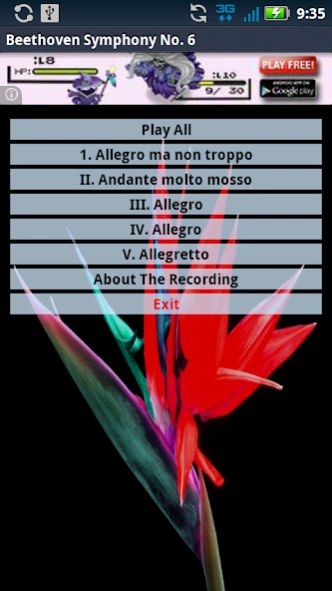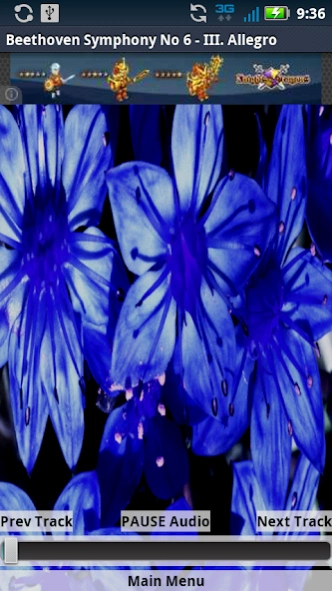Beethoven's Symphony No 6 1.3
Free Version
Publisher Description
Beethoven's Symphony No 6 - Enjoy Beethoven's Symphony Number 6 using the built-in Speakers or headphones
The symphony is scored for piccolo (fourth movement only), 2 flutes, 2 oboes, 2 clarinets in B flat, 2 bassoons, 2 horns in F and B flat, 2 trumpets in C and E flat (third, fourth, and fifth movements only), 2 trombones (alto and tenor, fourth and fifth movements only), timpani (fourth movement only), and strings.
I. Allegro ma non troppo 'Awakening of cheerful feelings on arrival in the countryside.'
The symphony begins with a placid and cheerful movement depicting the composer's feelings as he arrives in the country. The work is in sonata form, and its motifs are extensively developed. At several points Beethoven builds up orchestral texture by multiple repetitions of very short motifs. Yvonne Frindle commented,[6] "the infinite repetition of pattern in nature [is] conveyed through rhythmic cells, its immensity through sustained pure harmonies."
II. Andante molto mosso 'Scene by the brook.'
This movement, titled by Beethoven "By the brook," is in 12/8 meter; the key is B flat major, the subdominant of the main key of the work. The movement is in sonata form. At the opening the strings play a motif that clearly imitates flowing water. The cello section is divided, with just two players playing the flowing-water notes on muted instruments, with the remaining cellos playing mostly pizzicato notes together with the double basses. The cadenza of bird calls in the second movement; the intended species are labeled in German. Click to enlarge. Toward the end of the movement there is a cadenza for woodwind instruments that imitates bird calls. Beethoven helpfully identified the bird species in the score: nightingale (flute), quail (oboe), and cuckoo (two clarinets).
III. Allegro 'Merry gathering of country folk.'
This is a scherzo, which depicts country folk dancing and reveling. It is in F major, returning to the main key of the symphony. The form of the movement is an altered version of the usual form for scherzi, in that the trio appears twice rather than just once, and the third appearance of the scherzo theme is truncated. Perhaps to accommodate this rather spacious arrangement, Beethoven did not mark the usual internal repeats of the scherzo and the trio. Theodor Adorno identifies this scherzo as the model for the scherzos by Anton Bruckner.[7] The final return of the theme conveys a riotous atmosphere with a faster tempo. The movement ends abruptly, leading without a pause into the fourth movement.
IV. Allegro 'Thunder. Storm.'
The fourth movement, in F minor, depicts a violent thunderstorm with painstaking realism, building from just a few drops of rain to a great climax with thunder, lightning, high winds, and sheets of rain. The storm eventually passes, with an occasional peal of thunder still heard in the distance. There is a seamless transition into the final movement. This movement parallels Mozart's procedure in his String Quintet in G minor K. 516 of (1787), which likewise prefaces a serene final movement with a long, emotionally stormy introduction.[8]
V. Allegretto 'Shepherd's song. Happy and thankful feelings after the storm.'
The finale is in F major and is in 6/8 time. The movement is written in sonata rondo form, meaning that the main theme appears in the tonic key at the beginning of the development as well as the exposition and the recapitulation. Like many classical finales, this movement emphasizes a symmetrical eight-bar theme, in this case representing the shepherds' song of thanksgiving. The coda starts quietly and gradually builds to an ecstatic culmination for the full orchestra (minus "storm instruments"), with the first violins playing very rapid triplet tremolo on a high F. There follows a fervent passage suggestive of prayer, marked by Beethoven "pianissimo, sotto voce"; most conductors slow the tempo for this passage. After a brief period of afterglow, the work ends with two emphatic F major chords.
About Beethoven's Symphony No 6
Beethoven's Symphony No 6 is a free app for Android published in the Audio File Players list of apps, part of Audio & Multimedia.
The company that develops Beethoven's Symphony No 6 is Always Reliable Communications - Texas. The latest version released by its developer is 1.3.
To install Beethoven's Symphony No 6 on your Android device, just click the green Continue To App button above to start the installation process. The app is listed on our website since 2014-08-07 and was downloaded 7 times. We have already checked if the download link is safe, however for your own protection we recommend that you scan the downloaded app with your antivirus. Your antivirus may detect the Beethoven's Symphony No 6 as malware as malware if the download link to com.beethovan6 is broken.
How to install Beethoven's Symphony No 6 on your Android device:
- Click on the Continue To App button on our website. This will redirect you to Google Play.
- Once the Beethoven's Symphony No 6 is shown in the Google Play listing of your Android device, you can start its download and installation. Tap on the Install button located below the search bar and to the right of the app icon.
- A pop-up window with the permissions required by Beethoven's Symphony No 6 will be shown. Click on Accept to continue the process.
- Beethoven's Symphony No 6 will be downloaded onto your device, displaying a progress. Once the download completes, the installation will start and you'll get a notification after the installation is finished.



